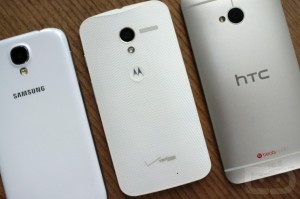In the highly competitive tech world, device manufacturers could be up one day and then down the next. Ten years ago laptops bumped aside desktop computers and now, tables are returning the favor. The same thing is happening in the smartphone industry. Cellphones with basic functionality gave way to more capable feature phones and finally these devices need to cede the ground to much more capable smartphone models. Change is the only unchangeable thing in the rapidly evolving mobile world and some observers are already wondering whether smartphones will someday be knocked off the perch. Wearable devices like smartwatches and Google Glass are seen as potential successors. With a wave of wearable gadgets are entering the fray, there is possibility Apple and Samsung will someday lose their dominance.
 Smartphones have easily reached the top of the tech market, but since technology tend to disappear very quickly; some experts think that this may not last forever. For big players like Samsung and Apple, smartphones represent a burgeoning business. They are fighting over the market share; while the functions and features have become much more commoditized. This is a classic occurrence and could happen in industry that becomes more mature. Although smartphones are quite sophisticated, just about any manufacturer could buy the components and put them together. There are hundreds of small smartphone makers that sell reasonable, budget models at affordable price.
Smartphones have easily reached the top of the tech market, but since technology tend to disappear very quickly; some experts think that this may not last forever. For big players like Samsung and Apple, smartphones represent a burgeoning business. They are fighting over the market share; while the functions and features have become much more commoditized. This is a classic occurrence and could happen in industry that becomes more mature. Although smartphones are quite sophisticated, just about any manufacturer could buy the components and put them together. There are hundreds of small smartphone makers that sell reasonable, budget models at affordable price.
Perhaps, it’s about time we see a disruption in the industry. Disruptions tend to happen when the current technologies mature. But most of the time, we don’t see disruptive technology, but instead disruption in business practices. High margins that Apple currently enjoys are steadily being eaten away by competitors like Samsung, Huawei, LG and others to be named. We already see smartphones with better characteristics, but priced at lower prices. In many cases, consumers know that paying higher price doesn’t always guarantee that they will get better devices. Big names in the industry are working hard to innovate and make sure their devices stay special. Google achieves this by creating a web of devices, including Google Glass, Smart TV and iCloud. This could help users to gain extra value for their smartphones. This is the true motivation behind innovations in the tech industry and differentiations are needed to make products stand out in the market. As the result, manufacturers could command larger market share and higher margins.
We have seen that new technologies wiped out old ones; although newer methods don’t necessarily better. This happened in the digital photography industry. Cameras with CCD technology were bulky and big. They were expensive and consume a lot of power to operate. The technology may be usable for video cameras, but not for compact, digital cameras used by average consumers. Newer CMOS cameras were cheaper, used less power and more compact. The technology allows manufacturers to put a couple of separate cameras into small mobile phone. As this happened, the CMOS technology not only replaced CCD, but also crushed the industry-standard film photography. Experts already warned manufacturers in the late 1990s that they would get their lunch eaten by the new CMOS technology. However, most camera makers argued that they had good margin with existing products: Film and instant cameras.
We still can’t confidently say that the same thing would happen in the smartphone industry. People will still buy and use smartphones in the short run. Nevertheless, the business would get much more complicated as new entrants will come in with their new devices. The actual demise of smartphones would depend on whether Apple, Samsung, Nokia-Microsoft and Motorola-Google are able to innovate and bring the entire industry to the next stage. Perhaps, the idea that smartphones are for communicating with others, browsing the web and playing games will eventually change.
Smartwatches and Google Glass are still at early development stages and they may not represent a threat to the smartphones industry. Their form factors still can’t accommodate powerful processor, improved cellular communication circuitry, large amount of internal storage and high-capacity battery. To get all of this, users still need their smartphones. People may easily predict the demise of current technologies, but this won’t happen as quickly as we would think. Often, it takes plenty of time and effort to replace and dismantle well-established technology. But it does happen, changes can happen very quickly.
Digital and film cameras were once available at the same time. But, no one bought film cameras within a span of a few years. So, digital cameras are kind of progressing along slowly and eventually replace film-based models. Desktops and laptops also went along rather smoothly and then, many consumers stopped using desktops all of a sudden.
Early smartphones had been around since late 1990s and they were going along with feature phones. But it wasn’t until Apple launched the original iPhone in 2007 when smartphones began to take off.
Instead of discussing about the possible demise of smartphones, we should re-examine why did they take off? Many would say that it happened because users have the necessity to connect to others through web-based communications means, not just the traditional voice- and text-based methods. Smartphones could also work as versatile tools, from stopwatch to gaming platform to document viewer. If something really has to replace smartphones, it should be able to the job well enough. In the end, consumers use a technology and buy a device to complete tasks.
The post Will Smartphones Get Replaced By New Disruptive Devices? appeared first on John's Phone - The World's Simplest Cell Phone.

إرسال تعليق